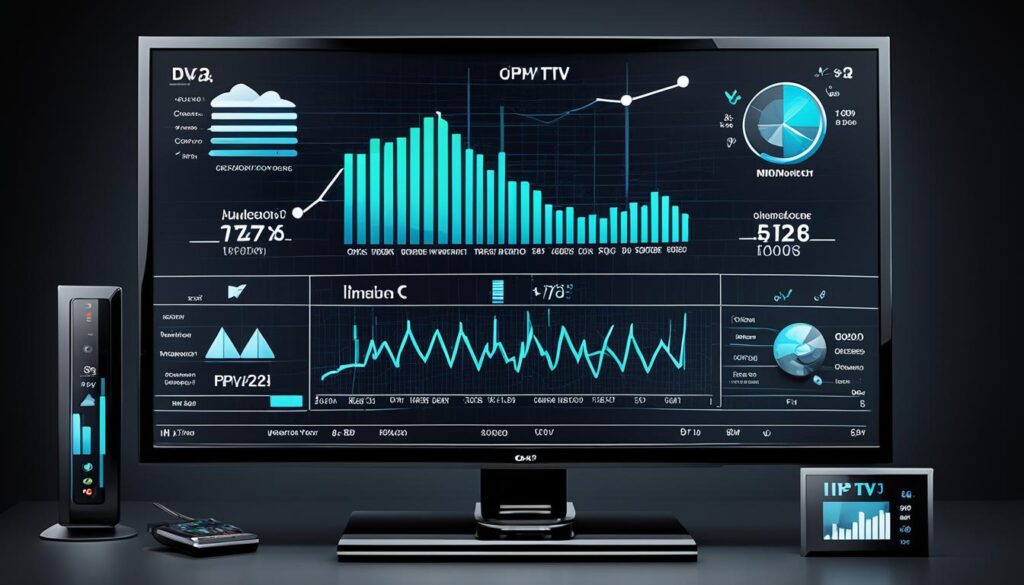Did you know IPTV analytics can greatly improve service quality and the way users enjoy it?
In today’s tough IPTV market, service providers aim to make their services better and draw in more users. Nora, from Setplex, is a strong asset. It provides deep insights into what subscribers watch, the money they bring in, and how content is consumed. These insights help providers take action that boosts their service’s performance, making services better and users happier.
Key Takeaways:
- IPTV analytics are crucial for improving service performance and user experience.
- Nora provides valuable insights into subscriber data, revenues, and content consumption.
- Data-driven decisions based on analytics can help service providers optimize services.
- Optimized services lead to increased user engagement and satisfaction.
- By leveraging IPTV analytics, service providers can stay ahead in the competitive market.
The Importance of Quality Metrics in IPTV
Quality metrics are key in measuring and bettering IPTV performance. They cover both tech stuff and what users say. This mix gives service providers a deep look into how good their IPTV is. With this info, they can tweak their services to provide better results for their viewers.
Things like bit rate, resolution, and frame rate show IPTV’s tech side. They help service providers see where they can do better.
But there’s also the stuff users directly say, like ratings and survey comments. This feedback helps providers understand what users actually think. By using both the tech data and user feedback, service providers get a full picture of their IPTV service’s quality. Then, they can decide on changes that will boost the whole viewing experience.
To explain the role of quality metrics, let’s look at an example:
Example: Comparing Quality Metrics for Two IPTV Services
| IPTV Service A | IPTV Service B |
|---|---|
| Bit Rate: 8 Mbps | Bit Rate: 4 Mbps |
| Resolution: 1080p | Resolution: 720p |
| Frame Rate: 30 fps | Frame Rate: 24 fps |
| Error Rate: 0.5% | Error Rate: 1.5% |
In comparing IPTV Service A and B, A has better quality numbers across the board. It flies higher in bit rate, resolution, frame rate, and has a lower error rate. This reflects a more top-notch service and overall viewing experience than B. With this data, providers can pinpoint improvement areas. This will ramp up viewers’ QoS and QoE from their IPTV services.
Grasping and using quality metrics helps service providers. It’s all about boosting their IPTV services. The result? Better performance, happier customers, and growth in business.

Measuring Quality Metrics for IPTV
It’s key to measure quality metrics in IPTV. This ensures services roll smoothly and users are happy. We need special tools to see both hard facts and what people think.
Objective Metrics
These metrics look at the tech side of the content delivery. We use network and media analyzers, and probes to check IP packets and videos. They help us see the service’s performance in things like bit rate, resolution, and error rate.
Subjective Metrics
User feedback and feelings about IPTV quality fall under subjective metrics. We get this from surveys, ratings, and feedback systems. They show service providers what users like, their needs, and what the service can do better.
Using both types of metrics gives a full view of IPTV quality. Methods like perceptual quality metrics and mean opinion score mix tech info with what users say. This way, service quality is seen through a complete lens.
Service providers should always measure and study these metrics. It helps them spot areas to improve and make smart changes. This leads to better service for users and higher-quality content.

| Objective Metrics | Subjective Metrics |
|---|---|
| Bit rate | User surveys |
| Resolution | Ratings |
| Frame rate | Feedback systems |
| Error rate |
Table: Examples of objective and subjective metrics used in IPTV quality measurement.
Improving Quality Metrics for IPTV
IPTV service providers can make their services better by tackling specific issues. To improve quality metrics, they face problems like congestion and packet loss. They deal with these by:
- Traffic shaping: This method controls data flow to ensure optimal network performance and reduce bottlenecks, leading to improved QoS.
- Error correction: By implementing error correction mechanisms, service providers can minimize packet loss and enhance the overall streaming experience.
- Buffering: Buffering stores data temporarily, avoiding issues from network lag. This makes playback smooth for viewers.
For video-related troubles, providers can focus on resolution and frame rate. They enhance these aspects by using:
- Adaptive Bitrate Streaming (ABR): ABR adjusts video quality to what the viewer’s internet can handle. This helps improve the Quality of Experience.
- Scalable Video Coding (SVC): SVC changes the video quality to match network speeds. It ensures high streaming quality.
- High-Efficiency Video Coding (HEVC): HEVC reduces video file size without losing quality. This enhances the streaming experience.
User-related problems can also be fixed. This involves strategies like:
- Personalization: By showing content that fits a user’s taste, providers boost satisfaction. This enhances the watching experience.
- Recommendation systems: Smart algorithms suggest shows based on what users like. This makes user choices better and boosts engagement.
- Interactivity: Features like live chats and interactive ads enhance the experience. They make watching TV more fun and engaging.
Overall, these strategies help service providers make their IPTV better. They improve quality and create a happier viewing for their customers.

The Role of Predictive Analytics in IPTV
Predictive analytics improves IPTV by using smart algorithms. This lets the service know about problems before they happen. By doing this, they can keep the show flowing smoothly. This makes everyone happier with their TV time.
With proactive analytics, errors are spotted and fixed before they bother watchers. This makes the service better as time goes on. Users get to enjoy their shows without interruption, increasing their happiness.
The Benefits of Predictive Analytics in IPTV Service Enhancement
Predictive analytics does a lot to make IPTV better:
- Real-time Issue Detection: It finds and fixes problems fast, making sure viewers have a great time.
- Optimization of QoS and QoE: It fine-tunes quality for a smooth, superior watch, episode after episode.
- Improved User Satisfaction: It makes viewers’ experiences better, keeping them happy and coming back for more.
- Continuous Improvement: It helps services learn from past data for constant upgrades, always aiming for a 10/10.
To wrap it up, predictive analytics helps services keep the good stuff coming without hiccups. It uses AI and quick data checks to stop problems before watches notice. This not only makes the service better but also keeps happy viewers loyal.
The Role of Predictive Analytics in Optimizing IPTV Performance
Predictive analytics spots where IPTV can do better. It uses past data to see what might go wrong next. This helps the service be ready for any twists and turns.
Thanks to predictive analytics, services can make everything about IPTV run smoother. For example, they:
| Aspect | Ways to Optimize |
|---|---|
| Bandwidth Allocation | They give out internet space based on what’s needed next. This reduces slowdowns and keeps things moving. |
| Content Recommendation | They guess what viewers want to watch and suggest it, making everyone’s watch time more fun. |
| Advertising Placement | They use data to figure out the best ad spots. This way, ads are helpful, not annoying, to people watching. |
| Content Delivery | They pick the best path to bring shows to viewers. This lessens pauses in the play and keeps shows running smoothly. |
By using predictive analytics, services can keep getting better. This means a TV experience that feels just right for everyone watching.

Implementing Predictive Analytics in IPTV Services
Setting up predictive analytics in IPTV needs to be thorough. It starts with:
- Data Collection: A lot of data is gathered, including what people like to watch, how the network is doing, and more.
- Data Analysis: Smart algorithms check this data to find what might need fixing or could get better.
- Proactive Optimization: With the findings, services can fix problems or make improvements early to keep shows top-notch.
- Continuous Monitoring: This work is never done. Services must always watch the data to catch new trends and keep making great choices.
By using predictive analytics, services can always be a step ahead. This means better performance and an awesome TV time for their viewers.
Using Quality Metrics to Improve IPTV User Experience
Quality metrics are key in making IPTV services better for users. By keeping track of these metrics like video quality and service stability, providers can meet user needs well. This data-driven approach lets providers offer top-notch content, making users happy and loyal.
Measuring quality metrics helps providers find out what’s working and what’s not. This way, they can see how users watch content and spot service issues. Using data, providers can tackle these issues head-on and make their service better for viewers.
Quality metrics shine a light on what matters most for users, such as video and channel quality. For instance, poor video quality might include buffering or fuzzy pictures. Providers can then work on these problems to ensure smoother video streaming, giving users a great watch time.
These metrics also let providers keep a close eye on their service. By watching KPIs, they can spot and fix problems quickly. For example, if videos start buffering more, they can jump in to make things run smoothly again. This fast action helps prevent disruptions for users.
Using quality metrics means providers can offer content that users really like. They look at what content is popular with users to create a library suited to everyone’s tastes. With recommendation systems, they can then suggest shows or movies individual users are likely to enjoy, boosting how much users like their IPTV service.
In summary, quality metrics are the foundation for improving the IPTV user experience. They help in making smart decisions to keep users satisfied and loyal. By using quality metrics to track, analyze, and improve, providers can ensure they offer great content and service. This keeps users happy and coming back.
| Benefits of Using Quality Metrics to Improve IPTV User Experience | |
|---|---|
| Enhanced video quality | Deliver high-quality content with smooth playback and minimal buffering. |
| Improved service stability | Proactively detect and resolve issues impacting service availability and reliability. |
| Personalized content recommendations | Curate content based on user preferences and drive user engagement. |
| Increased user satisfaction and loyalty | Optimize the IPTV user experience, leading to higher satisfaction and loyalty. |
Assessing Video Quality in IPTV
Special models and metrics are key for checking video quality in IPTV. These tools let providers check how well their service is running. They make sure people have a smooth time watching.
The dual-ended model is a common way to look at video quality. It compares the start video with what users see to find any quality problems. But, it’s not good for IPTV at home because it needs a special reference source.
The Moving Picture Quality Metrics (MPQM) model was made to fix this issue. It works with tech such as V-Factor to check video quality in real time without bothering viewers. It looks at things like compression and network issues to give an accurate quality score.
With the MPQM model, providers can learn a lot about what their viewers are seeing. This helps them quickly fix any problems. This means happier viewers who are more likely to stick around.
Benefits of the MPQM Model:
- Real-time assessment of video quality
- Non-intrusive measurement without the need for a reference source
- Considering various aspects that affect video quality
- Accurately evaluating the viewing experience of users
- Identifying and solving issues with video quality efficiently
Using the MPQM model, service providers can keep an eye on video quality. By making sure viewers get a great experience, they’ll be happier. This leads to more satisfied and involved users.
The Importance of End-to-end Monitoring in IPTV
End-to-end monitoring plays a key role in keeping IPTV services running smoothly. Service providers put devices in different network spots to watch over their service. This includes checking on video and sound quality. Such monitoring can spot problems early.
Knowing how end-to-end monitoring helps is crucial. It lets providers fix issues before viewers even notice them. This keeps the viewing experience top-notch.
Benefits of End-to-end Monitoring:
- IPTV service monitoring: It keeps track of key things like how much internet is being used, problems with data packets, and delays. This helps teams fix any network problems fast.
- Network performance assurance: This kind of monitoring makes sure the network can handle sending out high-quality videos and sounds. It allows for keeping the network in its best condition and cutting down on disruptions.
- Quick diagnosis and resolution: Finding and fixing issues right away is possible, thanks to the tool’s real-time nature. This approach helps in making the viewing experience smooth without delays.
- Improved customer satisfaction: Uninterrupted service pleases customers. It makes them happier with their service and more likely to stay.
End-to-end monitoring is vital for managing IPTV services well. It helps providers give the best content and viewing experience. Spending on good monitoring means keeping the network in good shape and solving problems fast. This way, service and customer satisfaction improve.
| Key Benefits of End-to-end Monitoring: | IPTV Service Monitoring | Network Performance Assurance | Quick Diagnosis and Resolution | Improved Customer Satisfaction |
|---|---|---|---|---|
| Explanation | Enables monitoring of key IPTV service metrics | Ensures network infrastructure supports high-quality streams | Facilitates real-time detection and troubleshooting | Enhances overall user experience and satisfaction |
Conclusion
IPTV analytics and quality metrics are crucial. They help improve service performance and the experience for users. With data analysis and predictive analytics, service providers can choose the best paths to refine their IPTV services.
Service providers learn key insights using IPTV analytics. They get to know subscriber data, revenues, and what content people watch. This information allows for smarter decisions that boost performance, service quality, and interaction with users.
Adding quality metrics helps service providers check and enhance their IPTV services. This means looking at things like bit rate and user surveys. By using both hard data and user opinions, providers can fully understand and improve their service quality.
FAQ
What is the role of analytics in service improvement?
Why are quality metrics important in IPTV?
How are quality metrics measured for IPTV?
How can quality metrics in IPTV be improved?
What is the role of predictive analytics in IPTV?
How can quality metrics be used to improve IPTV user experience?
How is video quality assessed in IPTV?
Why is end-to-end monitoring important in IPTV?
How can IPTV service performance be improved using analytics?





